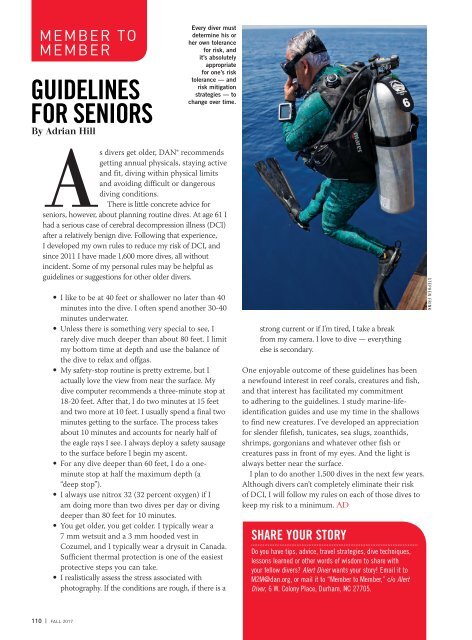AD 2017 Q4
Alert Diver is the dive industry’s leading publication. Featuring DAN’s core content of dive safety, research, education and medical information, each issue is a must-read reference, archived and shared by passionate scuba enthusiasts. In addition, Alert Diver showcases fascinating dive destinations and marine environmental topics through images from the world’s greatest underwater photographers and stories from the most experienced and eloquent dive journalists in the business.
Alert Diver is the dive industry’s leading publication. Featuring DAN’s core content of dive safety, research, education and medical information, each issue is a must-read reference, archived and shared by passionate scuba enthusiasts. In addition, Alert Diver showcases fascinating dive destinations and marine environmental topics through images from the world’s greatest underwater photographers and stories from the most experienced and eloquent dive journalists in the business.
Create successful ePaper yourself
Turn your PDF publications into a flip-book with our unique Google optimized e-Paper software.
MEMBER TO<br />
MEMBER<br />
GUIDELINES<br />
FOR SENIORS<br />
By Adrian Hill<br />
Every diver must<br />
determine his or<br />
her own tolerance<br />
for risk, and<br />
it’s absolutely<br />
appropriate<br />
for one’s risk<br />
tolerance — and<br />
risk mitigation<br />
strategies — to<br />
change over time.<br />
As divers get older, DAN® recommends<br />
getting annual physicals, staying active<br />
and fit, diving within physical limits<br />
and avoiding difficult or dangerous<br />
diving conditions.<br />
There is little concrete advice for<br />
seniors, however, about planning routine dives. At age 61 I<br />
had a serious case of cerebral decompression illness (DCI)<br />
after a relatively benign dive. Following that experience,<br />
I developed my own rules to reduce my risk of DCI, and<br />
since 2011 I have made 1,600 more dives, all without<br />
incident. Some of my personal rules may be helpful as<br />
guidelines or suggestions for other older divers.<br />
• I like to be at 40 feet or shallower no later than 40<br />
minutes into the dive. I often spend another 30-40<br />
minutes underwater.<br />
• Unless there is something very special to see, I<br />
rarely dive much deeper than about 80 feet. I limit<br />
my bottom time at depth and use the balance of<br />
the dive to relax and offgas.<br />
• My safety-stop routine is pretty extreme, but I<br />
actually love the view from near the surface. My<br />
dive computer recommends a three-minute stop at<br />
18-20 feet. After that, I do two minutes at 15 feet<br />
and two more at 10 feet. I usually spend a final two<br />
minutes getting to the surface. The process takes<br />
about 10 minutes and accounts for nearly half of<br />
the eagle rays I see. I always deploy a safety sausage<br />
to the surface before I begin my ascent.<br />
• For any dive deeper than 60 feet, I do a oneminute<br />
stop at half the maximum depth (a<br />
“deep stop”).<br />
• I always use nitrox 32 (32 percent oxygen) if I<br />
am doing more than two dives per day or diving<br />
deeper than 80 feet for 10 minutes.<br />
• You get older, you get colder. I typically wear a<br />
7 mm wetsuit and a 3 mm hooded vest in<br />
Cozumel, and I typically wear a drysuit in Canada.<br />
Sufficient thermal protection is one of the easiest<br />
protective steps you can take.<br />
• I realistically assess the stress associated with<br />
photography. If the conditions are rough, if there is a<br />
strong current or if I’m tired, I take a break<br />
from my camera. I love to dive — everything<br />
else is secondary.<br />
One enjoyable outcome of these guidelines has been<br />
a newfound interest in reef corals, creatures and fish,<br />
and that interest has facilitated my commitment<br />
to adhering to the guidelines. I study marine-lifeidentification<br />
guides and use my time in the shallows<br />
to find new creatures. I’ve developed an appreciation<br />
for slender filefish, tunicates, sea slugs, zoanthids,<br />
shrimps, gorgonians and whatever other fish or<br />
creatures pass in front of my eyes. And the light is<br />
always better near the surface.<br />
I plan to do another 1,500 dives in the next few years.<br />
Although divers can’t completely eliminate their risk<br />
of DCI, I will follow my rules on each of those dives to<br />
keep my risk to a minimum. <strong>AD</strong><br />
SHARE YOUR STORY<br />
Do you have tips, advice, travel strategies, dive techniques,<br />
lessons learned or other words of wisdom to share with<br />
your fellow divers? Alert Diver wants your story! Email it to<br />
M2M@dan.org, or mail it to “Member to Member,” c/o Alert<br />
Diver, 6 W. Colony Place, Durham, NC 27705.<br />
STEPHEN FRINK<br />
110 | FALL <strong>2017</strong>









